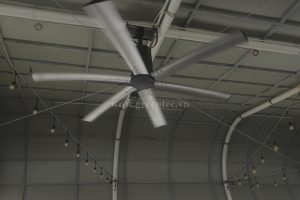
13 Dec WHAT IS VENTILATION
Ventilation (V-shaped in HVAC, air-conditioning systems) is the process of “changing” or replacing air in any space to provide high quality air inside (ie for heat control). degrees, add oxygen, or remove moisture, odors, smoke, heat, dust, airborne bacteria, and carbon dioxide). Ventilation systems are used to eliminate unpleasant odors and excessive moisture, to bring in outside air, maintain air circulation in buildings, and to prevent stagnation of air. gas inside.

Ventilation solution by HVLS industrial fans
Ventilation includes both air exchange with the outside as well as air circulation in a building. This is one of the most important factors to maintain the air quality within buildings at an acceptable level. The ventilation methods of a building can be divided into two types: mechanical or natural.
“Mechanical” or “forced” ventilation is used to control the internal air quality. Excessive moisture, odors, toxic substances can often be controlled by diluting or replacing with outside air. However, in humid climates, more energy is needed to remove excessive moisture from the air.
Ventilation will increase the amount of energy needed for heating and cooling, but heat recovery ventilation can be used to reduce energy consumption. This involves exchanging heat between the incoming and outgoing gas flows. In addition, heat recovery ventilation also includes moisture exchange.
Stoves and bathrooms often have mechanical exhaust pipes to control odors and sometimes moisture. The kitchen also has other problems facing like smoke and grease. Design elements of such systems include flow (which is a function of fan speed and exhaust size) and noise level. If the duct for the fan passes through an unheated space (e.g. attic), the ducts must be insulated to prevent condensation on the duct. Direct blowing fans are available for many devices, and can reduce maintenance needs.
Ceiling fans and table fans circulate room air with the aim of reducing the heat generated by the evaporation of sweat from the skin of the people living in it. Because of the hot air flying, ceiling fans can be used to keep rooms warmer in the winter by circulating warm air stratified from the ceiling to the floor. Ceiling fans do not create ventilation nor bring in air from outside.
Natural ventilation is the ventilation of a building with outside air without the use of fans or other mechanical systems. This can be achieved with open windows or drip vents when space for ventilation is small and the architecture allows for this. In more complex systems, the warm air in a building can be allowed to soar and escape in the upper opening (chimney effect) thus forcing the cool air flow on the outside to be pulled. naturally draws into the building through openings in the lower area. These systems use very little energy but must be carefully preserved to ensure the comfort of occupants. In warm or humid months, in many climates, maintaining temperature comfort that only through natural ventilation may not be feasible, so air-conditioning systems Usually will be used to assist. Air-saving components perform the same functions as natural ventilation, but they use mechanical fans, ducts, damper, and control systems to bring in and distribute the air. Coordinate cool air stream when appropriate.



No Comments